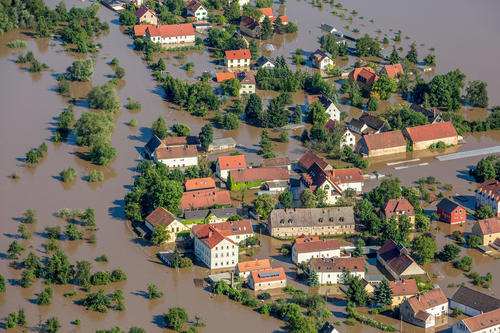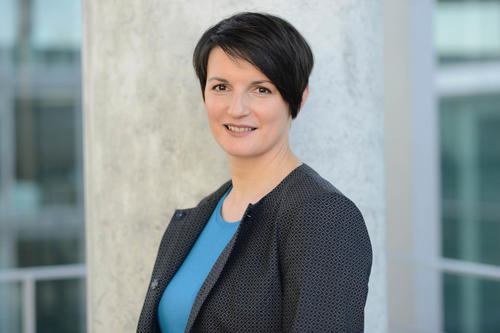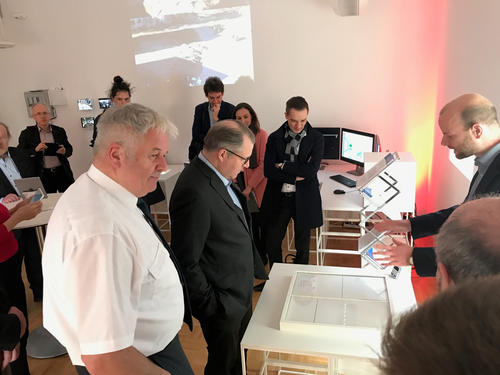Analyzing and Averting Risks
Future Lab of Research Forum on Public Safety and Security at Freie Universität opens its doors
Apr 15, 2019
A rising tide: Floods like the one along the Elbe River in Radebeul, Saxony, in June 2013 are increasingly common.
Image Credit: euroluftbild.de/Peter Schubert
Irene Mihalic, internal policy spokesperson of the Alliance 90/The Green Party parliamentary group, values dialogue with academia and the research sector.
Image Credit: Stefan Kaminski
Safety and security researcher Roman Peperhove (right) explains to Albrecht Broemme (THW president, left) and Bundestag members Michael Kuffer (CSU, center) and Benjamin Strasser (FDP, background) how to find an escape route out of a maze.
Image Credit: Simone Harr/ECDF
Irene Mihalic, a member of the Bundestag for the Green Party, doesn’t have far to go. The Future Security Lab is practically right across the street.
The future lab operated by the Research Forum on Public Safety and Security at Freie Universität Berlin, which opened a few days ago, is located at the Einstein Center Digital Future at Wilhelmstraße 67. Right across the street is the Jakob-Kaiser-Haus, where members of parliament sit and committees meet; the Reichstag building rises behind it.
The lab’s proximity to the seat of government is no accident. “Our goal here is to make recent research findings on civilian safety and security understandable and accessible in the truest sense of the word – and not just to experts, but also, and especially, to politicians and decision makers,” explains Lars Gerhold, the head of the future lab and a professor of interdisciplinary safety and security research at Freie Universität. “Being in close physical proximity helps with that,” he adds.
To Mihalic, the fact that the lab presents issues of safety and security, which otherwise tend to be abstract, in a vivid and easily understandable way is a plus for her political work on the Bundestag’s Committee on Internal Affairs and Community. She says, “I can imagine taking a little field trip here with colleagues at some point in addition to a committee hearing.”
And policy makers aren’t the only ones to benefit from the close physical proximity: Researchers can also connect with legislators, directly presenting their findings for discussion themselves. That is also true of the experts at the center, the scholars and researchers of the Einstein Center Digital Future, who are studying digital trends and how they affect our society.
The Future Security Lab, which is supported through funding from the German Federal Ministry of Education and Research (BMBF), has a great deal to offer despite its modest size: All around the walls are large screens and small tablets that provide information on technical innovations aimed at improving public safety and security or explain findings from safety and security research to visitors. The digital age in particular has brought with it new technologies that can represent both problems and solutions at the same time. On the one hand, they create new avenues of attack for hackers and criminals, while on the other, they offer previously undreamt-of ways to solve safety and security dilemmas old and new.
One monitor at the lab demonstrates a surveillance software program, but the faces of the people in the video have been blurred. High-resolution images like those used in the facial recognition pilot project operated by the Ministry of the Interior at Berlin’s Südkreuz train station for a year starting in August 2017 aren’t needed everywhere, explains Roman Peperhove, head of the coordination office at the Research Forum on Public Safety and Security. He says, “In fact, for many locations it doesn’t matter at all who is where, but only how many people there are in a certain location.” In an emergency – at Tegel Airport, for example – the only critical piece of information is how many people are in what places so that they can be systematically guided to their closest emergency exits.
Mihalic, who experienced many dangerous situations in real life during her time as an active police officer, can draw on the detailed work researchers have done with new software to help in her work in the German parliament. “Those of us in politics, and I am no exception myself, can sometimes be receptive to supposedly simple solutions that are presented.” With that in mind, she explains, she appreciates the fact that the Future Security Lab also considers technical issues from the perspectives of social sciences, politics, and practical application. “The lab makes it clear that video surveillance can take different forms, depending on what is needed.”
The showroom’s interdisciplinary nature is also apparent in the wide range of exhibits on display. One table holds virtual reality goggles that take visitors inside a collapsed building. It is soon clear that an attack has taken place there. The windows are shattered, and injured people are lying on the stone floor, some of them bleeding. The user can move through the building virtually, entering other rooms where further victims are located. This software can help first responders practice for real-world emergencies.
Another wall at the lab holds a tablet showing a topographic map of the United States. When Gerhold moves his finger over a control, the sea level suddenly starts to rise. Parts of Florida and the East Coast are soon underwater. The program simulates the effects of flooding produced by climate change – and how it will affect areas where different segments of the population live.
“How hard hit people are by a warming climate doesn’t depend only on where they live, but also on their social situation,” Gerhold says. That includes things like whether it is possible for those affected to move to another area or absorb the financial losses caused by flooding. “Social inequality is a big factor when it comes to safety and security.” Similar scenarios can also be run for Europe: What kind of migration should be expected if, for example, rising seas flood the low-lying coastal areas of the Netherlands a few decades from now?
To optimize current legislation and political processes and review regulations that are already in place, the researchers work together in interdisciplinary projects using a wide range of methods, with various cooperation partners from real-world practice. One team of researchers from Freie Universität worked with Deutsche Bahn, for example, under Gerhold’s leadership to conduct a survey of local transit users; the goal is to find out how safe people feel when they use public transit and in which specific situations they start to feel unsafe.
The researchers could then compare these data on perceived safety against empirical analyses of real threats, Gerhold explains. He continues, “People aren’t actually as afraid of being assaulted or robbed as we thought, but they do tend to feel stressed by overcrowding. But flows of visitors are specifically a question of management, and that’s something that can also be resolved with technology.”
Since research on safety and security is in flux, researchers also have to consider new issues, Gerhold says. Most of the responsibility for ensuring public safety and security used to rest with the state, while more recently, the focus has turned increasingly to individual disaster preparedness and private security firms, he explains. “These days, we’re seeing a kind of ‘mechanization of safety and security,’ by which I mean we'd prefer to solve all our problems with technology.”
But solutions aimed at improving public safety and security should not be driven by technology alone. There are also ethical and social aspects that need to be considered, Gerhold explains, pointing to the facial recognition software that is already in widespread use in some countries as an example. The algorithms used by these kinds of software are not infallible, and in serious cases, they could undermine the presumption of innocence.
“Take a program with 99.9 percent accuracy, for example: With an error rate of 0.1 percent, do we accept that people may be wrongfully suspected of crimes?” The most important thing, he says, is the discourse around this subject: “Safety and security isn’t just a given. It’s the result of a process of negotiation between various players in the fields of research, the general public, and politics.”
Mihalic, for her part, is happy to have the chance to engage in this kind of dialogue. The discussion over, she says goodbye and heads back to work – right across the street.
Research Forum
The mission of the Research Forum on Public Safety and Security is to function as a central clearinghouse for the public policy, research, and business sectors on all matters concerning public safety and security. Founded at Freie Universität in 2009, the forum brings together research projects and findings from various disciplines and institutions on the subject of public safety and security. The goal is to study and evaluate developments in this field from a scholarly perspective and recommend actions to take for politicians, the wider economy, and organizations. The research forum traces its origins to a multiparty parliamentary initiative in 2007.
This text originally appeared in German on February 23, 2019, in the Tagesspiegel newspaper supplement published by Freie Universität.
Further Information
Prof. Dr. Lars Gerhold, Freie Universität Berlin, Fachgebiet Interdisziplinäre Sicherheitsforschung, Forschungsforum Öffentliche Sicherheit, Tel.: +49 30 838 51 693, mail: lars.gerhold@fu-berlin.de



